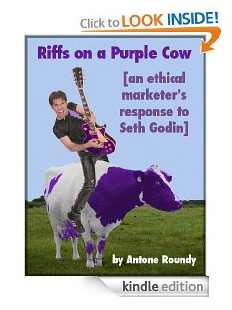What to Put in Your Internet Marketing Videos
by Antone Roundy | 3 Comments | Marketing, Product Reviews, Video
I read recently that parts of the brain respond the same to watching someone else do something as they do when the person does it themself. To those parts of the brain, a vicarious experience is just as real as an actual, first person experience.
For example, a video of a kid unboxing his new Wii got 71,000 views in its first week. Why? Were the viewers enjoying envying the kid with the Wii while they sat at home without one? Not likely. The video earned their time and attention by giving them a taste of the same joy the kid in the video was experiencing.
I'd guess that if the kid had stuck his tongue out at the camera and said, "Ha, ha! I've got a Wii and all you've got is hand-held yahtzee!" it wouldn't have had the same effect, or the same success.
What does this mean for marketing videos?
You don't want to just talk about your product, and you probably don't want to just show a screen capture video of you using it either. You want your videos to show a person doing rewarding things, or in a desirable state that's related to the product. If your product makes something really easy, show a video of someone doing it and finishing up quickly, relaxed, and not taxed by the experience.
Sometimes you see screen capture videos where the person talking is shown in a little box in the corner (using a webcam). I don't know that this is always a good thing, because it obscures part of the screen, and sometimes it seems totally unrelated to the message. But perhaps when doing rewarding activities, it might help people connect with the experience, especially if it's not important for them to see the details of what's happening on the computer screen.
I found out about this phenomenon in a book titled "Buyology: Truth and Lies About Why We Buy", by Martin Lindstrom.
The book is full of information revealed by brain scans. For example:
- Memory of a product is a key indicator of the probability of future purchase.
- "Now" stimulates emotion and increases memory -- for example, "in less the 3 minutes, you can have [desirable result]".
- People naturally respond favorably to infant's faces.
- Men tend to experience pleasure watching the guilty get punished (there was no mention of women).
- Love sells better than sex -- photos of "wholesome attractiveness" boost sales better than "sexy" images.
For more insights and information about what makes people buy, check out the book for yourself.






October 17th, 2010 at 10:02 pm
For the majority of my videos I just use a regular old web cam. I tried to use free software that captured what I was doing on screen, but the voice was way off of what was happening with the video. Do you recommend any software which would be good to capture video and keep up with the voice?
October 18th, 2010 at 9:12 am
I use Camtasia. (I was lucky enough to pick it up at a time when they had a deal where you could download a really old version AND get a free key to unlock it, and then upgrade at half price).
The version I use (a few versions out of date) does pretty bad audio editing. So I usually just do the screen capture, and then record voice overs in Audacity and import them into Camtasia. I'd imagine they've probably improved the audio editing by now.
If you're on a Mac, you might try Screenflow. It costs less, and looks better than my old version of Camtasia.
October 19th, 2010 at 10:51 am
Thank you for this because I'm also building a checklist on how to develop content for videos to get the brainstorming session started.
The usual advice is make it entertaining/funny and informative. But your guideline of thinking of 'rewarding emotional experiences' that viewers would want to experience vicariously is real useful.
It made me think of my then 7 yr. old nephew who was into all sorts of paper folding crafts (guns, animals, and etc). And I saw this kid (who is used to high-tech entertainment such as playstation, gameboy, and i-pod) get excited and his eyes light up when I handed him a tape dispenser! Sense of wonder for simple things is something we adults want to re-experience again.